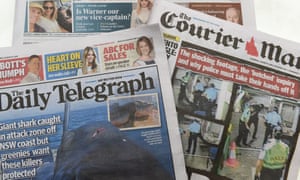
Rupert Murdoch’s Australian tabloids are making the majority of their photographers and subeditors redundant in a radical cost-cutting move designed to keep the ailing newspaper business afloat.
The director of editorial management, Campbell Reid, said the restructure of the traditional newsroom was needed to “preserve in print and excel in digital”.
The Daily Telegraph, the Herald Sun and the Courier-Mail are set to lose dozens of staff each – the Queensland masthead alone will cut 45 – although the company is not revealing the total number of job losses.
The announcement follows a cost-cutting drive in December which saw 42 journalists, artists and photographers made redundant in a bid to slash $40m from News Corp.
Last week the Gold Coast Bulletin was told it had to lose 10 jobs, and sources said dozens of people had been quietly made redundant already this year across all the mastheads.
News Corp said the old model of staff photographers would be retired for a “hybrid model, consisting of a core team of photographic specialists, complemented by freelance and agency talent”.
At a meeting at Sydney’s Holt Street headquarters, the Daily Telegraph editor, Chris Dore, told staff the photographers would lose their permanent status but may be hired back as casuals and freelancers.
Staff at the Herald Sun were told News Corp “is in a fight for its life”.
There was no mention at the meeting of the company’s financial losses which are behind the move. In February News Corp posted a second-quarter loss of $287m and cited impairments in the Australian newspaper business as a key factor. The Australian editors were summoned to the US for a meeting about making substantial cuts to operations.
News described the changes as a modernisation of the newsroom which would “simplify in-house production and maximise the use of available print technology for print edition production”.
“Like every other business today, we have to identify opportunities to improve and modernise the way we work to become __more efficient,” Reid said.
“We need to organise our editorial operations so we can preserve in print and excel in digital. This requires a new approach to long-standing newsroom processes.
“Our core franchise is journalism and we will always protect and preserve that. These changes do not diminish our commitment to quality nor our faith in the long-term future of all our publishing platforms.
“At a time when trusted, credible news content is paramount, we must ensure our contemporary newsrooms are shaped to deliver the news, analysis, features and services that match modern reader needs, whether in print, digital, on mobile, or in video or audio.”
On Tuesday afternoon staff across the country were briefed on the changes, but management refused to answer questions about how many jobs would go.
In Melbourne, staff of the Herald Sun were briefed by Victorian managing director of editorial, Peter Blunden. As many as 40 jobs are expected to go from the Herald Sun. The Australian appears to be immune from this round.
A $60m content management system called Methode – introduced by former CEO Kim Williams in 2012 – would enable journalists to edit, lay out and publish their own stories, bypassing the need for subeditors and production journalists, sources said.
“The investment in Methode plays a foundation stone role in engaging our customers,” Williams said before he stepped down in 2013.
“It will allow us to create once and publish many times across every platform our customers use – print, online, tablet, mobile, smart devices, and broadcast. We are a media company and we have confidence in all the forms of media that Methode will serve, enabling our journalists to produce great material efficiently.
“The new operating model is designed to empower staff to work smarter and faster. We will upskill our central functions and eliminate wasteful duplication.
“The new model addresses areas where we have skill shortages and are duplicating functions. We will hire new people where required, but regrettably some roles will become redundant.”
Ironically, Williams’ grand plan to restructure News Corp, which faced fierce resistance within the company and in part led to his departure, has now largely been adopted as the company faces even __more severe conditions in the media business. After leaving, Williams accused News Corp, of “vaingloriously ignoring facts” about the future of digital news.
The Media, Entertainment and Arts Alliance said up to two-thirds of the photographic staff will be cut in some cities.
Significant changes to work practices are likely, including earlier deadlines, greater copy sharing across cities and mastheads, and journalists doing production roles.
“The job redundancies that will result which will only serve to strip vital editorial talent from the company’s mastheads, harm the very products that News Corp’s audiences value and end up being self-defeating because of the damage they do,” the union’s media section director, Katelin McInerney, said.
“Cutting the very staff who tell the stories of our society’s marginalised and vulnerable – particularly those photojournalists who create the images we, as audiences, rely on to cut to the heart of an issue in a powerful, compelling and instantaneous way – has proved an ultimately futile stop-gap measure for news companies,” McInerney said.
The cuts at News follow major cuts announced last week by rival Fairfax Media which aim to remove $30m annually from the editorial budget by losing dozens of journalists and photographers.